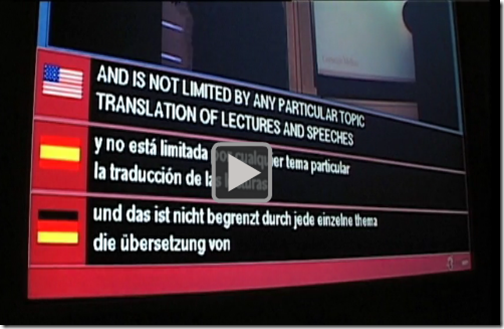As anyone who has used Google Translate can testify, machine-based translation tools are far from perfect. In the end, human intervention - at times heavy, and often unwelcome, editing - is still necessary. However, as the following article explains, the field of computer-based language
translation is growing at a rapid pace, as evident from the emergence of
several promising programs. Hopefully we will see a workable tool in the future
that can help overcome language barriers. As of now, it's work in progress, with
humans still the best translators.
The world is becoming increasingly connected as businesses grow globally and people can come together around the world through the power of the Internet. But all this growth doesn’t necessarily mean we all understand each other; there are still major language barriers to overcome. Fortunately, the field of language translation is experiencing rapid growth as well, with developers exploring and creating new ways to help people understand each other, no matter the language. Here, we’ll take a look at some of the most incredible translation tools of today, and how they might grow tomorrow.
1. Humans
That’s right; one of the most amazing translation tools of tomorrow is real, live people. Although machine translation is incredibly useful and cost-effective for large scale translation projects, human translators are still essential for final preparation and revision of sophisticated texts.
2. Linguee
This tool combines both an editorial dictionary and search engine, allowing users to look through a reliable editorial dictionary with translations, as well as see example sentences from other sources, showing how expressions are translated into context. This tool is an interesting example of what can be done with human translation when combined with effective technology. Linguee will continue to grow in the future, adding languages like Chinese and Japanese for even more translation power.
The future of translation is open source, and there are already many open translation tools available today. Computer aided translation tools, machine translation platforms, and even open translation communities bring the world together to make translation easier and open to everyone. We can expect to see a lot of growth in this field as more projects come together to create open translation tools.
Using statistical data, translation tools will soon be able to use contextual information to determine the best understanding of words to translate. With this ability, experts believe we will be able to show translated spoken word nearly in real time for speeches, lectures, and more. This can be displayed on viewing screens, or, even more amazingly, through goggles that would overlay the words as the viewer looks at the speaker.
Although it’s currently in use today, Google Translate is an amazing tool using tomorrow’s translation technology. By looking for patterns in documents that have already been translated by human translators, Google Translate makes intelligent guesses for appropriate translations. Although not all translations are perfect, this tool is constantly evolving and growing as it learns more from human-translated documents.
6. Vocre
This start-up has introduced a new translation tool that offers audio translations within video calls. The tool has a FaceTime-like video interface, and allows instant translation communication, as well as reflection of body language and tone. Vocre CEO Andrew Lauder says the tool is "the beginning of a new communication revolution by enabling anyone to carry an interpreter in their pocket." This tool is not yet available to everyone, but there is a beta sign-up for those who are interested in taking advantage of next-generation video translation.
7. Smartling
Smartling offers a tool for websites and apps to go multilingual with the help of crowd-sourced translations. Publishers can use community translators, and when needed, supplement with machine translations and professional translators. This allows for lightning-fast translation work, with some websites adding as many as 14 whole languages in a matter of three weeks. This tool continues to grow as it gets millions more in funding and attracts big sites like Scribd and SurveyMonkey to its services.
Most people are familiar with AltaVista’s BabelFish service, and even the Babel Fish device on The Hitchhiker’s Guide to the Galaxy, which allows users to turn their voices into a different language. Microsoft has recently introduced a new service, Text to Speech, that does exactly that, but instead of outputting a robotic translation, reflects the original speaker’s voice, and even tone and accent. Experts are excited about this new development, as well as the possibilities that it presents for mobile apps in the travel industry.
Powered by Bing, Facebook users can soon opt-in to inline language translations for comments, posts, and more, making it incredibly east to connect with friends, family, and colleagues from around the world on Facebook. Even more impressive, this next generation tool is constantly improving itself, as bilingual users can enter their own translations that are typically more accurate, and other users can vote on the positive accuracy of their translations, replacing machine translations.
10. Crowdin
Crowdin offers an incredible collaborative translation tool, taking advantage of the power of both machine translations and human translations through translation memory. In a Crowdin project, users are able to upload pre-translated works, and then create a community that can edit and perfect translations. This can happen anywhere thanks to translation synchronizing and translation migrations, allowing collaboration from users around the world.









No comments:
Post a Comment
Please adhere to proper blog etiquette when posting your comments. This blog owner will exercise his absolution discretion in allowing or rejecting any comments that are deemed seditious, defamatory, libelous, racist, vulgar, insulting, and other remarks that exhibit similar characteristics. If you insist on using anonymous comments, please write your name or other IDs at the end of your message.